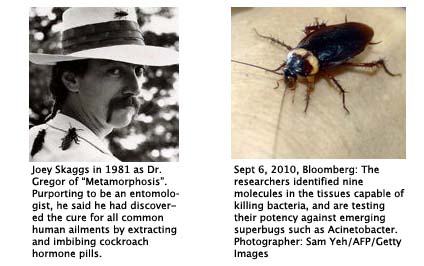Submitted by Dave Camp, saying “Prescient again”? Dave is referring to a hoax Joey Skaggs did in 1981 called “Metamorphosis“. Skaggs said he was an entomologist who had discovered cures for all of mankind’s common ailments such as colds, flus, acne, anemia and menstrual cramps, by extracting and eating cockroach hormones. Is history repeating itself? Or, was Skaggs really onto something?
Here’s the article:
Cockroach Brains May Be a Source of Antibiotics, Research Says
by Simeon Bennett
Bloomberg
September 6, 2010
Cockroach brains may be a source of new antibiotics capable of killing deadly drug-resistant bacteria, according to research that suggests the germ-spreading pests may be good for something after all.
Insects such as cockroaches have a defense mechanism against bacteria, a “logical” development from living in unhygienic conditions, research from the U.K.”™s University of Nottingham showed. Tissues from the brains and nervous systems of cockroaches and locusts killed more than 90 percent of MRSA and E. coli without damaging human cells, scientists said.
Research has shown cockroaches to spread germs linked to allergic reactions and asthma in the home and drug-resistant bacteria in hospitals. Invasive MRSA, or methicillin-resistant Staphylococcus aureus, is a hospital-acquired infection that sickens about 90,000 people and kills 15,000 in the U.S. every year, according to the Centers for Disease Control and Prevention in Atlanta.
“Insects often live in unsanitary and unhygienic environments where they encounter many different types of bacteria,” Simon Lee, a postgraduate researcher who led the study, said in a statement yesterday. “It is therefore logical that they have developed ways of protecting themselves against micro-organisms.”
The researchers identified nine molecules in the tissues capable of killing bacteria, and are testing their potency against emerging superbugs such as Acinetobacter. Infections caused by the bacteria, commonly found in soil and water, typically occur in intensive-care units and health-care facilities with very ill patients, according to the CDC.
E. coli can cause diarrhea and may lead to urinary tract infections and pneumonia, the agency said.
The study was presented at the Society for General Microbiology“™s meeting in Nottingham, England.

